BA 217 Company Law: Joint Ventures and Partnerships Analysis
VerifiedAdded on 2023/06/08
|7
|1513
|172
Case Study
AI Summary
This case study provides a comprehensive analysis of joint ventures and partnerships within the framework of company law. It begins by defining both joint ventures and partnerships, highlighting the distinctions between general, limited, and joint venture partnerships. The study then explores leading cases that have shaped the legal understanding of joint ventures, emphasizing elements such as mutual purpose, control equality, and shared profits/losses. Current issues in defining joint ventures, such as joint cash control and regular financial reporting, are addressed. The study also references lawful joint venture associations across various industries, including railroad and mining. Furthermore, it offers advice for those considering establishing either a joint venture or partnership, stressing the importance of understanding the chosen arrangement and its consequences. Finally, the study acknowledges the fragility of these enterprises and suggests measures to minimize disputes, particularly regarding corporate strategy, governance, and IP rights. The document concludes with a list of references.
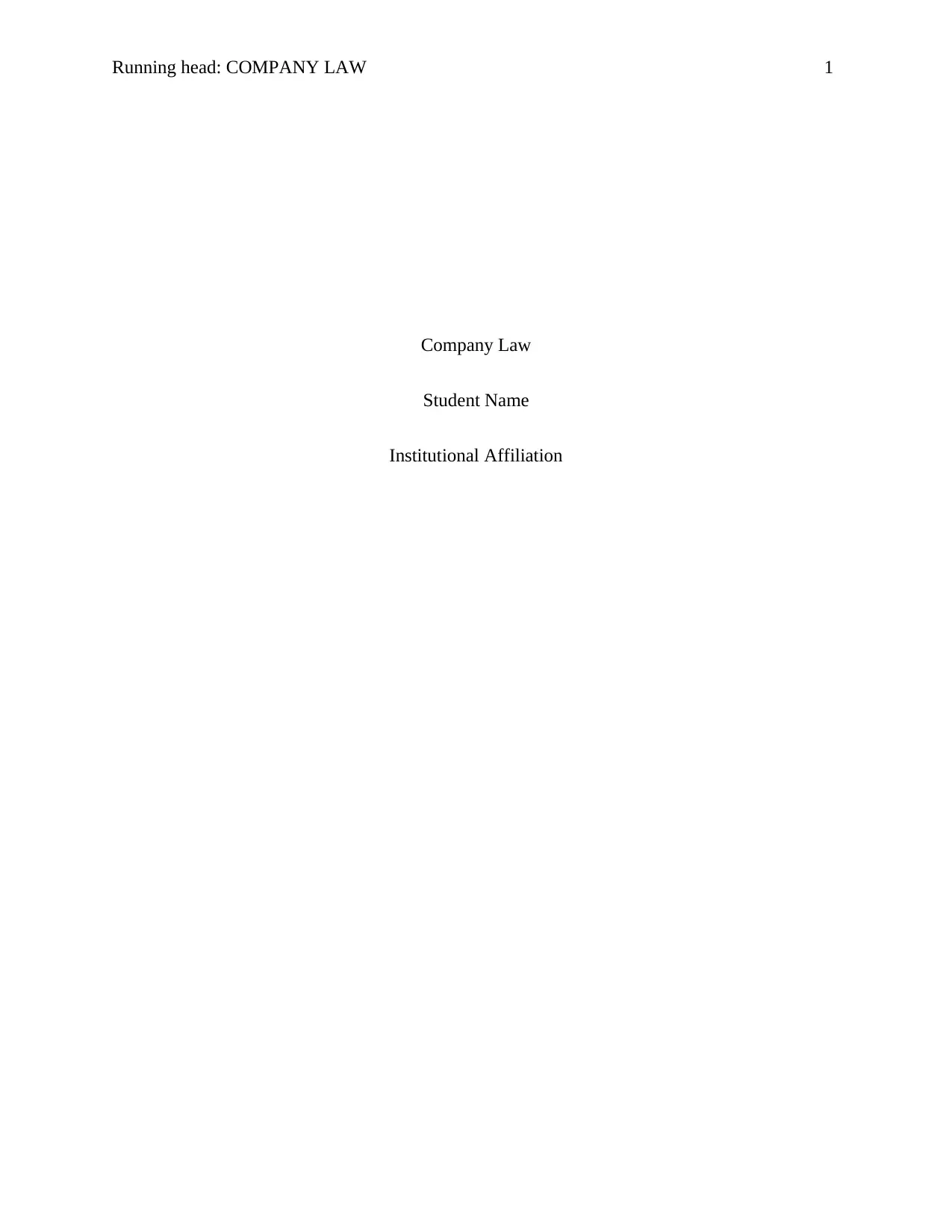
Running head: COMPANY LAW 1
Company Law
Student Name
Institutional Affiliation
Company Law
Student Name
Institutional Affiliation
Paraphrase This Document
Need a fresh take? Get an instant paraphrase of this document with our AI Paraphraser
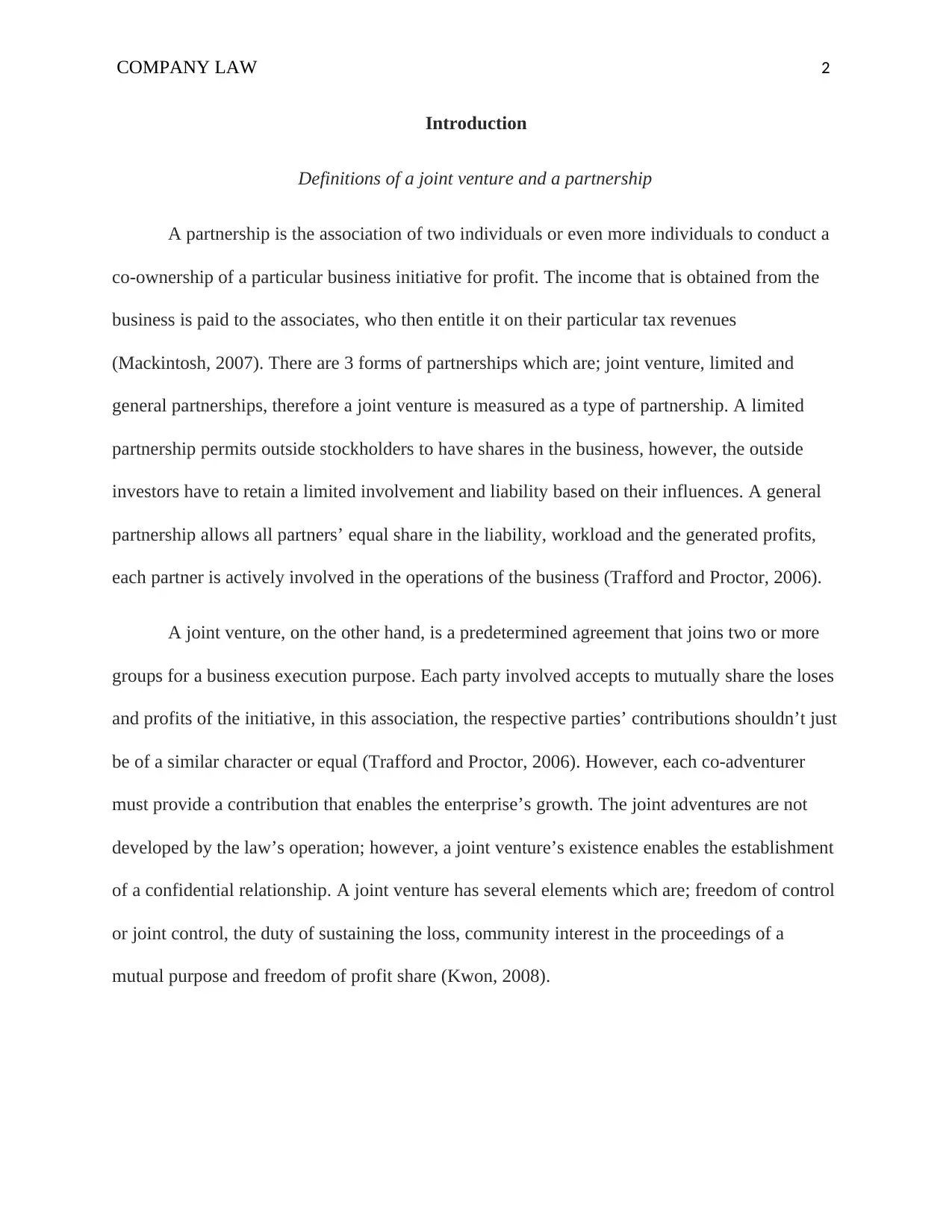
COMPANY LAW 2
Introduction
Definitions of a joint venture and a partnership
A partnership is the association of two individuals or even more individuals to conduct a
co-ownership of a particular business initiative for profit. The income that is obtained from the
business is paid to the associates, who then entitle it on their particular tax revenues
(Mackintosh, 2007). There are 3 forms of partnerships which are; joint venture, limited and
general partnerships, therefore a joint venture is measured as a type of partnership. A limited
partnership permits outside stockholders to have shares in the business, however, the outside
investors have to retain a limited involvement and liability based on their influences. A general
partnership allows all partners’ equal share in the liability, workload and the generated profits,
each partner is actively involved in the operations of the business (Trafford and Proctor, 2006).
A joint venture, on the other hand, is a predetermined agreement that joins two or more
groups for a business execution purpose. Each party involved accepts to mutually share the loses
and profits of the initiative, in this association, the respective parties’ contributions shouldn’t just
be of a similar character or equal (Trafford and Proctor, 2006). However, each co-adventurer
must provide a contribution that enables the enterprise’s growth. The joint adventures are not
developed by the law’s operation; however, a joint venture’s existence enables the establishment
of a confidential relationship. A joint venture has several elements which are; freedom of control
or joint control, the duty of sustaining the loss, community interest in the proceedings of a
mutual purpose and freedom of profit share (Kwon, 2008).
Introduction
Definitions of a joint venture and a partnership
A partnership is the association of two individuals or even more individuals to conduct a
co-ownership of a particular business initiative for profit. The income that is obtained from the
business is paid to the associates, who then entitle it on their particular tax revenues
(Mackintosh, 2007). There are 3 forms of partnerships which are; joint venture, limited and
general partnerships, therefore a joint venture is measured as a type of partnership. A limited
partnership permits outside stockholders to have shares in the business, however, the outside
investors have to retain a limited involvement and liability based on their influences. A general
partnership allows all partners’ equal share in the liability, workload and the generated profits,
each partner is actively involved in the operations of the business (Trafford and Proctor, 2006).
A joint venture, on the other hand, is a predetermined agreement that joins two or more
groups for a business execution purpose. Each party involved accepts to mutually share the loses
and profits of the initiative, in this association, the respective parties’ contributions shouldn’t just
be of a similar character or equal (Trafford and Proctor, 2006). However, each co-adventurer
must provide a contribution that enables the enterprise’s growth. The joint adventures are not
developed by the law’s operation; however, a joint venture’s existence enables the establishment
of a confidential relationship. A joint venture has several elements which are; freedom of control
or joint control, the duty of sustaining the loss, community interest in the proceedings of a
mutual purpose and freedom of profit share (Kwon, 2008).
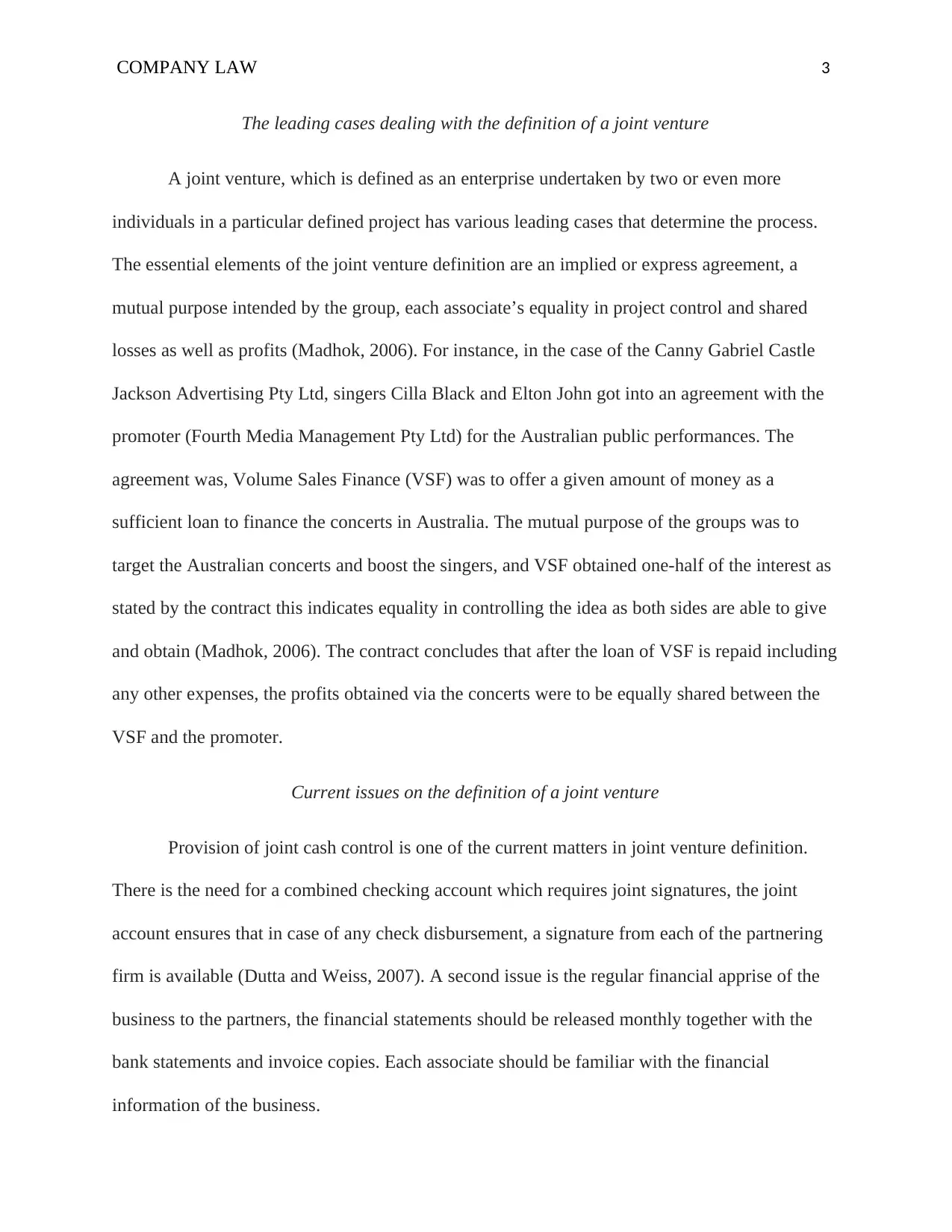
COMPANY LAW 3
The leading cases dealing with the definition of a joint venture
A joint venture, which is defined as an enterprise undertaken by two or even more
individuals in a particular defined project has various leading cases that determine the process.
The essential elements of the joint venture definition are an implied or express agreement, a
mutual purpose intended by the group, each associate’s equality in project control and shared
losses as well as profits (Madhok, 2006). For instance, in the case of the Canny Gabriel Castle
Jackson Advertising Pty Ltd, singers Cilla Black and Elton John got into an agreement with the
promoter (Fourth Media Management Pty Ltd) for the Australian public performances. The
agreement was, Volume Sales Finance (VSF) was to offer a given amount of money as a
sufficient loan to finance the concerts in Australia. The mutual purpose of the groups was to
target the Australian concerts and boost the singers, and VSF obtained one-half of the interest as
stated by the contract this indicates equality in controlling the idea as both sides are able to give
and obtain (Madhok, 2006). The contract concludes that after the loan of VSF is repaid including
any other expenses, the profits obtained via the concerts were to be equally shared between the
VSF and the promoter.
Current issues on the definition of a joint venture
Provision of joint cash control is one of the current matters in joint venture definition.
There is the need for a combined checking account which requires joint signatures, the joint
account ensures that in case of any check disbursement, a signature from each of the partnering
firm is available (Dutta and Weiss, 2007). A second issue is the regular financial apprise of the
business to the partners, the financial statements should be released monthly together with the
bank statements and invoice copies. Each associate should be familiar with the financial
information of the business.
The leading cases dealing with the definition of a joint venture
A joint venture, which is defined as an enterprise undertaken by two or even more
individuals in a particular defined project has various leading cases that determine the process.
The essential elements of the joint venture definition are an implied or express agreement, a
mutual purpose intended by the group, each associate’s equality in project control and shared
losses as well as profits (Madhok, 2006). For instance, in the case of the Canny Gabriel Castle
Jackson Advertising Pty Ltd, singers Cilla Black and Elton John got into an agreement with the
promoter (Fourth Media Management Pty Ltd) for the Australian public performances. The
agreement was, Volume Sales Finance (VSF) was to offer a given amount of money as a
sufficient loan to finance the concerts in Australia. The mutual purpose of the groups was to
target the Australian concerts and boost the singers, and VSF obtained one-half of the interest as
stated by the contract this indicates equality in controlling the idea as both sides are able to give
and obtain (Madhok, 2006). The contract concludes that after the loan of VSF is repaid including
any other expenses, the profits obtained via the concerts were to be equally shared between the
VSF and the promoter.
Current issues on the definition of a joint venture
Provision of joint cash control is one of the current matters in joint venture definition.
There is the need for a combined checking account which requires joint signatures, the joint
account ensures that in case of any check disbursement, a signature from each of the partnering
firm is available (Dutta and Weiss, 2007). A second issue is the regular financial apprise of the
business to the partners, the financial statements should be released monthly together with the
bank statements and invoice copies. Each associate should be familiar with the financial
information of the business.
⊘ This is a preview!⊘
Do you want full access?
Subscribe today to unlock all pages.

Trusted by 1+ million students worldwide
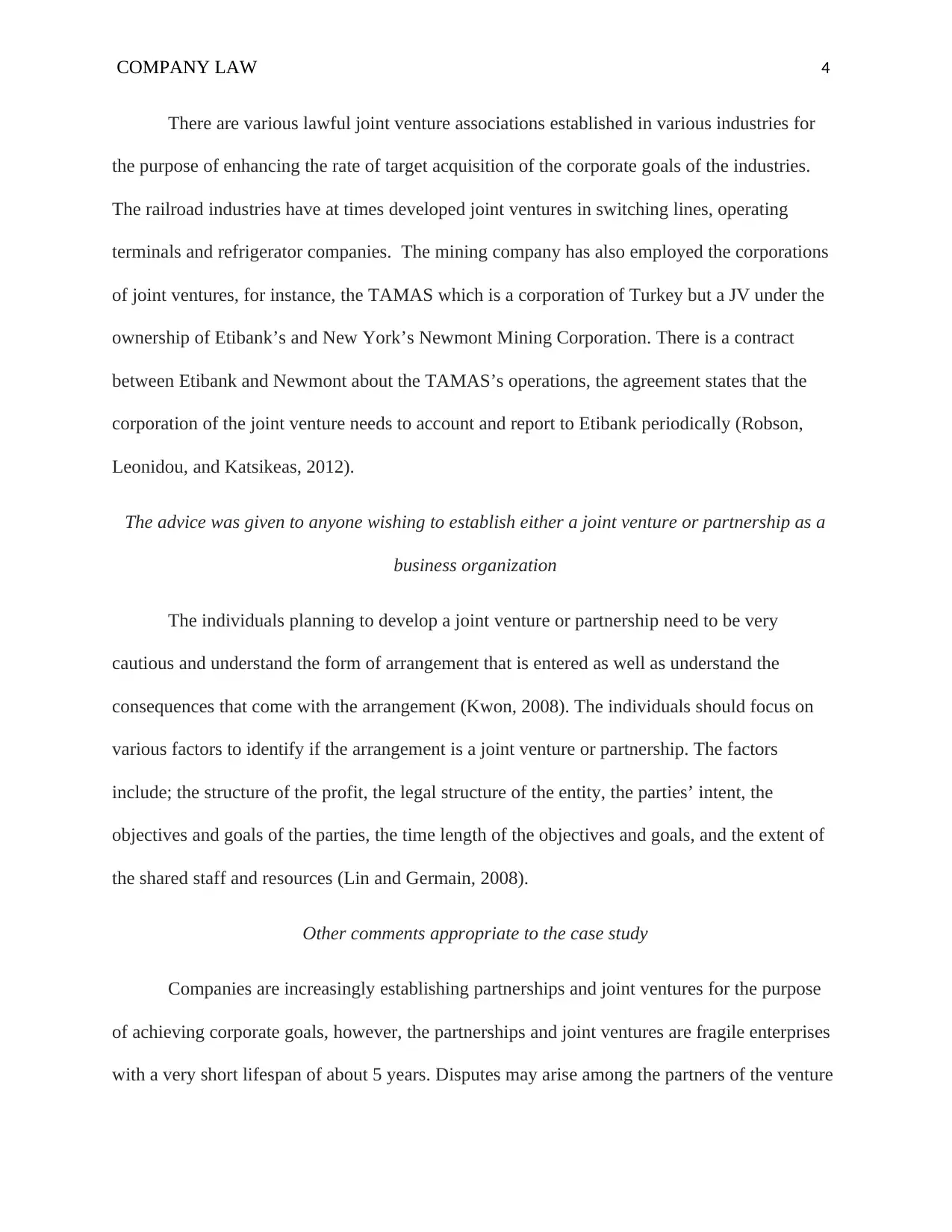
COMPANY LAW 4
There are various lawful joint venture associations established in various industries for
the purpose of enhancing the rate of target acquisition of the corporate goals of the industries.
The railroad industries have at times developed joint ventures in switching lines, operating
terminals and refrigerator companies. The mining company has also employed the corporations
of joint ventures, for instance, the TAMAS which is a corporation of Turkey but a JV under the
ownership of Etibank’s and New York’s Newmont Mining Corporation. There is a contract
between Etibank and Newmont about the TAMAS’s operations, the agreement states that the
corporation of the joint venture needs to account and report to Etibank periodically (Robson,
Leonidou, and Katsikeas, 2012).
The advice was given to anyone wishing to establish either a joint venture or partnership as a
business organization
The individuals planning to develop a joint venture or partnership need to be very
cautious and understand the form of arrangement that is entered as well as understand the
consequences that come with the arrangement (Kwon, 2008). The individuals should focus on
various factors to identify if the arrangement is a joint venture or partnership. The factors
include; the structure of the profit, the legal structure of the entity, the parties’ intent, the
objectives and goals of the parties, the time length of the objectives and goals, and the extent of
the shared staff and resources (Lin and Germain, 2008).
Other comments appropriate to the case study
Companies are increasingly establishing partnerships and joint ventures for the purpose
of achieving corporate goals, however, the partnerships and joint ventures are fragile enterprises
with a very short lifespan of about 5 years. Disputes may arise among the partners of the venture
There are various lawful joint venture associations established in various industries for
the purpose of enhancing the rate of target acquisition of the corporate goals of the industries.
The railroad industries have at times developed joint ventures in switching lines, operating
terminals and refrigerator companies. The mining company has also employed the corporations
of joint ventures, for instance, the TAMAS which is a corporation of Turkey but a JV under the
ownership of Etibank’s and New York’s Newmont Mining Corporation. There is a contract
between Etibank and Newmont about the TAMAS’s operations, the agreement states that the
corporation of the joint venture needs to account and report to Etibank periodically (Robson,
Leonidou, and Katsikeas, 2012).
The advice was given to anyone wishing to establish either a joint venture or partnership as a
business organization
The individuals planning to develop a joint venture or partnership need to be very
cautious and understand the form of arrangement that is entered as well as understand the
consequences that come with the arrangement (Kwon, 2008). The individuals should focus on
various factors to identify if the arrangement is a joint venture or partnership. The factors
include; the structure of the profit, the legal structure of the entity, the parties’ intent, the
objectives and goals of the parties, the time length of the objectives and goals, and the extent of
the shared staff and resources (Lin and Germain, 2008).
Other comments appropriate to the case study
Companies are increasingly establishing partnerships and joint ventures for the purpose
of achieving corporate goals, however, the partnerships and joint ventures are fragile enterprises
with a very short lifespan of about 5 years. Disputes may arise among the partners of the venture
Paraphrase This Document
Need a fresh take? Get an instant paraphrase of this document with our AI Paraphraser
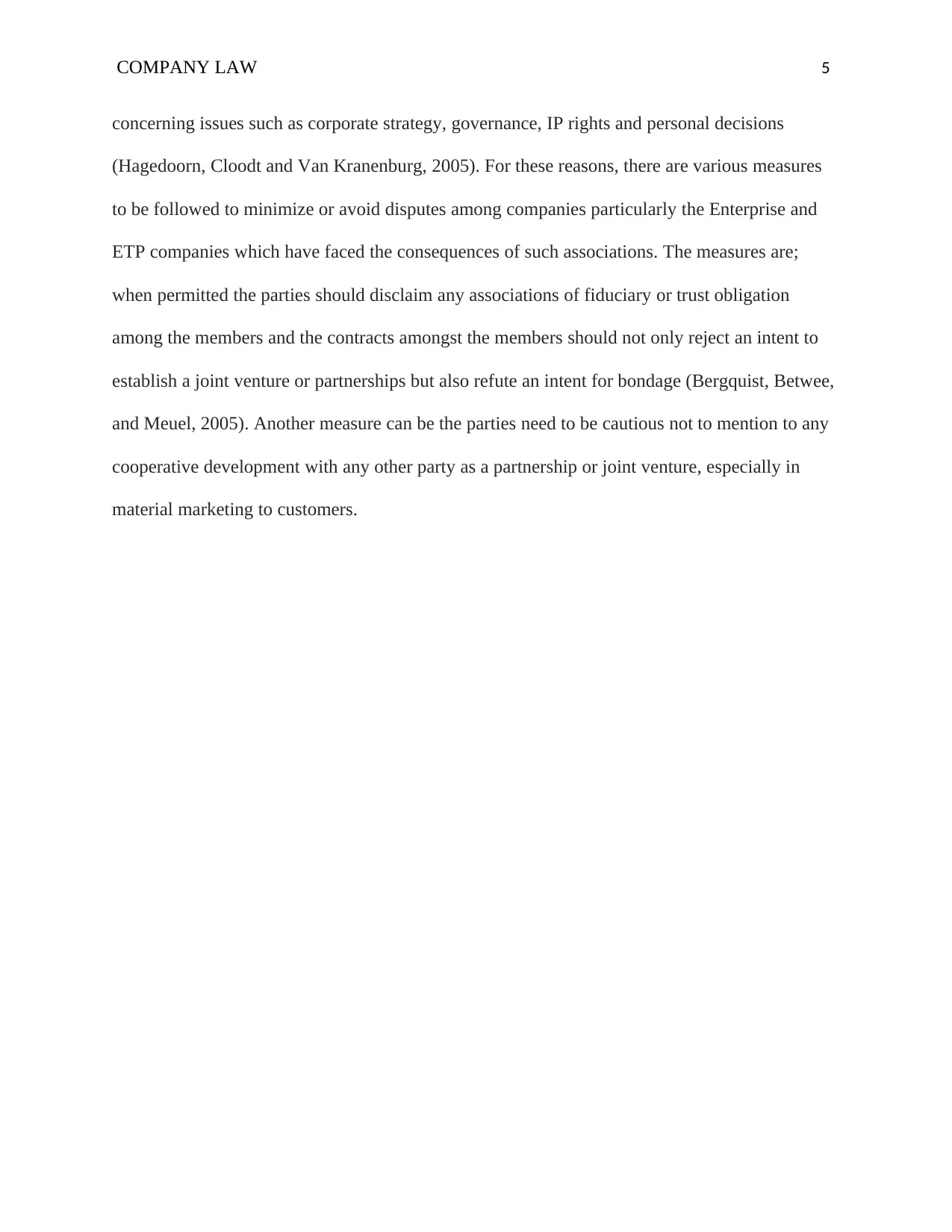
COMPANY LAW 5
concerning issues such as corporate strategy, governance, IP rights and personal decisions
(Hagedoorn, Cloodt and Van Kranenburg, 2005). For these reasons, there are various measures
to be followed to minimize or avoid disputes among companies particularly the Enterprise and
ETP companies which have faced the consequences of such associations. The measures are;
when permitted the parties should disclaim any associations of fiduciary or trust obligation
among the members and the contracts amongst the members should not only reject an intent to
establish a joint venture or partnerships but also refute an intent for bondage (Bergquist, Betwee,
and Meuel, 2005). Another measure can be the parties need to be cautious not to mention to any
cooperative development with any other party as a partnership or joint venture, especially in
material marketing to customers.
concerning issues such as corporate strategy, governance, IP rights and personal decisions
(Hagedoorn, Cloodt and Van Kranenburg, 2005). For these reasons, there are various measures
to be followed to minimize or avoid disputes among companies particularly the Enterprise and
ETP companies which have faced the consequences of such associations. The measures are;
when permitted the parties should disclaim any associations of fiduciary or trust obligation
among the members and the contracts amongst the members should not only reject an intent to
establish a joint venture or partnerships but also refute an intent for bondage (Bergquist, Betwee,
and Meuel, 2005). Another measure can be the parties need to be cautious not to mention to any
cooperative development with any other party as a partnership or joint venture, especially in
material marketing to customers.
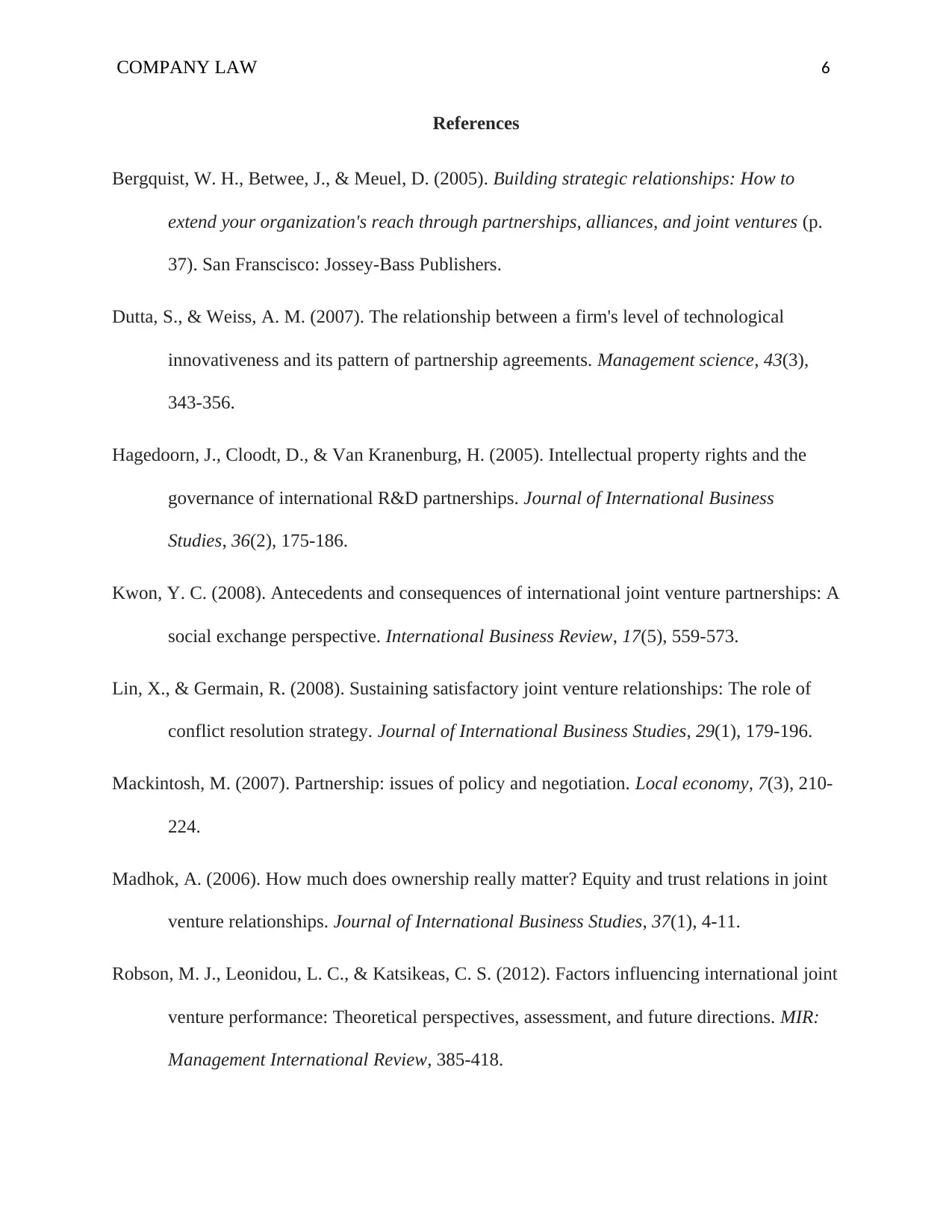
COMPANY LAW 6
References
Bergquist, W. H., Betwee, J., & Meuel, D. (2005). Building strategic relationships: How to
extend your organization's reach through partnerships, alliances, and joint ventures (p.
37). San Franscisco: Jossey-Bass Publishers.
Dutta, S., & Weiss, A. M. (2007). The relationship between a firm's level of technological
innovativeness and its pattern of partnership agreements. Management science, 43(3),
343-356.
Hagedoorn, J., Cloodt, D., & Van Kranenburg, H. (2005). Intellectual property rights and the
governance of international R&D partnerships. Journal of International Business
Studies, 36(2), 175-186.
Kwon, Y. C. (2008). Antecedents and consequences of international joint venture partnerships: A
social exchange perspective. International Business Review, 17(5), 559-573.
Lin, X., & Germain, R. (2008). Sustaining satisfactory joint venture relationships: The role of
conflict resolution strategy. Journal of International Business Studies, 29(1), 179-196.
Mackintosh, M. (2007). Partnership: issues of policy and negotiation. Local economy, 7(3), 210-
224.
Madhok, A. (2006). How much does ownership really matter? Equity and trust relations in joint
venture relationships. Journal of International Business Studies, 37(1), 4-11.
Robson, M. J., Leonidou, L. C., & Katsikeas, C. S. (2012). Factors influencing international joint
venture performance: Theoretical perspectives, assessment, and future directions. MIR:
Management International Review, 385-418.
References
Bergquist, W. H., Betwee, J., & Meuel, D. (2005). Building strategic relationships: How to
extend your organization's reach through partnerships, alliances, and joint ventures (p.
37). San Franscisco: Jossey-Bass Publishers.
Dutta, S., & Weiss, A. M. (2007). The relationship between a firm's level of technological
innovativeness and its pattern of partnership agreements. Management science, 43(3),
343-356.
Hagedoorn, J., Cloodt, D., & Van Kranenburg, H. (2005). Intellectual property rights and the
governance of international R&D partnerships. Journal of International Business
Studies, 36(2), 175-186.
Kwon, Y. C. (2008). Antecedents and consequences of international joint venture partnerships: A
social exchange perspective. International Business Review, 17(5), 559-573.
Lin, X., & Germain, R. (2008). Sustaining satisfactory joint venture relationships: The role of
conflict resolution strategy. Journal of International Business Studies, 29(1), 179-196.
Mackintosh, M. (2007). Partnership: issues of policy and negotiation. Local economy, 7(3), 210-
224.
Madhok, A. (2006). How much does ownership really matter? Equity and trust relations in joint
venture relationships. Journal of International Business Studies, 37(1), 4-11.
Robson, M. J., Leonidou, L. C., & Katsikeas, C. S. (2012). Factors influencing international joint
venture performance: Theoretical perspectives, assessment, and future directions. MIR:
Management International Review, 385-418.
⊘ This is a preview!⊘
Do you want full access?
Subscribe today to unlock all pages.

Trusted by 1+ million students worldwide

COMPANY LAW 7
Trafford, S., & Proctor, T. (2006). Successful joint venture partnerships: public-private
partnerships. International Journal of Public Sector Management, 19(2), 117-129.
Trafford, S., & Proctor, T. (2006). Successful joint venture partnerships: public-private
partnerships. International Journal of Public Sector Management, 19(2), 117-129.
1 out of 7
Related Documents
Your All-in-One AI-Powered Toolkit for Academic Success.
+13062052269
info@desklib.com
Available 24*7 on WhatsApp / Email
![[object Object]](/_next/static/media/star-bottom.7253800d.svg)
Unlock your academic potential
Copyright © 2020–2025 A2Z Services. All Rights Reserved. Developed and managed by ZUCOL.





